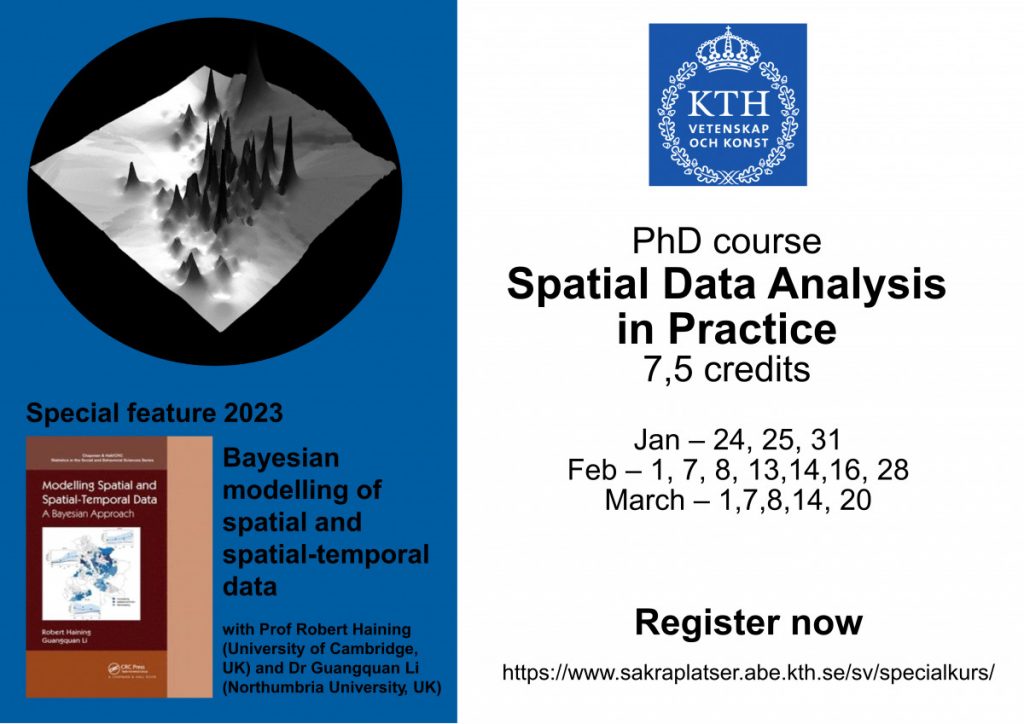PhD course

PhD KTH course: Spatial data analysis in practice – SDAP, FAG3170
Registration form below
Headteacher: Prof Vania Ceccato
Duration: From January to March
Place: Department of Urban Planning and Built Environment at the School of Architecture and the Built Environment at KTH
Visiting teachers: Prof Robert Haining, University of Cambridge, UK and Dr Guangquan Li, Northumbria University, UK
Fee: SEK 8000
The course is 100% face-to-face.
Contact person: Vania Ceccato
1. Motivation
Spatial data analysis involves exploratory and confirmatory analyses that facilitate and enhance decision making with spatial data. This includes techniques that help visualize data, identify patterns and processes, detect outliers and anomalies, test hypotheses and theories, and generate new spatial data and knowledge. It is therefore not a surprise that spatial data analysis is an emerging field, with advancing technologies and evolving applications that are fundamental for a number of sciences, geography, architecture and urban planning, transportation, criminology, demography, epidemiology and economics, just to name a few. Mobile data and location based services, from apps, allied to Geographical Information Systems (GIS) provide the necessary setting for enhanced analysis of patterns and process over time and space. The KTH course Spatial Data Analysis in Practice – SDAP (course code FAG3170) offers examples of conceptual and applied research on spatial analysis capturing some of the most recent developments in this area.
2. Course aim and learning outcomes
Spatial data analysis in practice involves an encompassing set of skills that includes manipulation of spatial data, exploration of spatial statistics techniques, modelling in combination with Geographic
Information Systems. In this course students are trained to become users of spatial data analysis techniques. Students will gain a broad knowledge of the diversity of current approaches, which methods are at hand and examples of applications using spatial data analysis in different fields (e.g.,). After completing the course the students should be able to:
• identify the appropriate approaches/techniques in spatial data analysis
• use relevant knowledge to solve spatial-related problems using real-life data sets and spatial statistical tools, including visualization, interpolation, pattern identification and modeling (spatial regression analysis)
• develop both technical and social skills by working in pairs to solve real-life problems using different statistical software
• to analyze results of practical exercises and be able to point out challenges and advantages with those tested techniques
• develop, interpret and critically reflect upon results of a case study using one (or more)spatial data analysis technique(s) learned during the course.
• be able to use their new skills in spatial data techniques and communicating them to an audience (written, graphically and orally).
• recognize and express the value of incorporating the spatial dimension of phenomena and processes in social sciences
3. Main content
The course is composed of 15 lectures divided in 3 parts. In the first part the nature of the geographical data is discussed whilst the identification of spatial patterns is the focus in the second part of the course together with the theoretical introduction to confirmatory spatial data analysis. The third part deals with examples of applications spatial data analysis/visualization of large share of data and development of the final project.
PART I – Thinking spatially: introduction to GIScience/The nature of spatial data, Data quality/Spatial structure of spatial data/Exploratory spatial data analysis PART II – Area interpolation, ESDA cluster detection methods, Introduction to confirmatory analysis, OLS regression analysis and spatial modelling/autoregressive models.
PART III – Examples of applications spatial data analysis/ visualization of large share of data/Glimpses of future of spatial data analysis/Project (study case) and Project presentation.
3. The structure of the course and learning activities
The course is composed of lectures followed by practical exercises1, about 1 hour long after the lecture. Practical exercises provide contextualized step-by-step instructions to students so they can apply the appropriate approaches to real-life datasets and obtain the results that can be later used for their analysis. Real-life examples make learning more interesting for the students simply by giving life to theory which is far too often dry and abstract. A ‘forum time’ when students may raise issues (after each practical exercise but before each new lecture) will be part of the daily schedule (about 15 minutes). These activities provide feedback to the students as they learn.
Reading is an essential part of the course. Reading the required literature before each lecture is highly encouraged to all students.
The final assessment is based on the development of a project. In groups of two, students are trained to “make a case” of why they want to test a certain type of technique using real-life data sets (case study project), with hypothesis testing. Students need to show that they are using the technique properly (according to intended learning outcomes) and provide results. Students have also to think critically about their results and chosen technique. If the technique or data were not adequate.
Registration form
